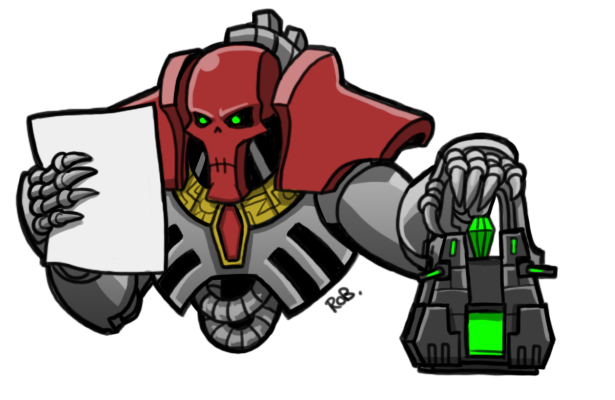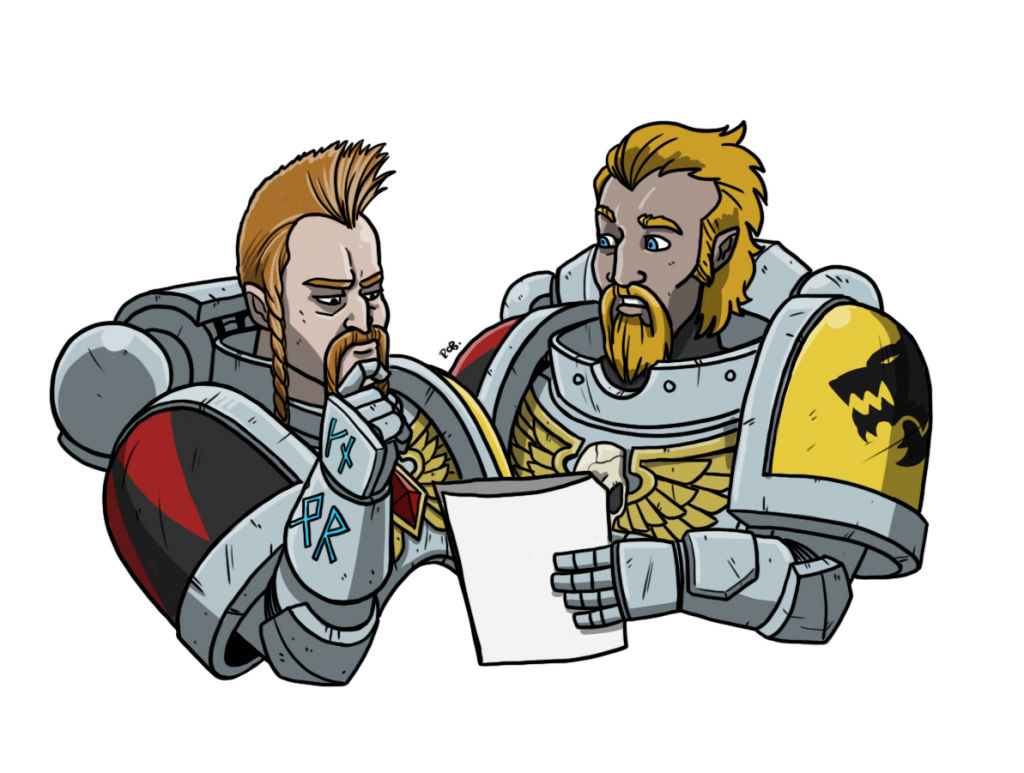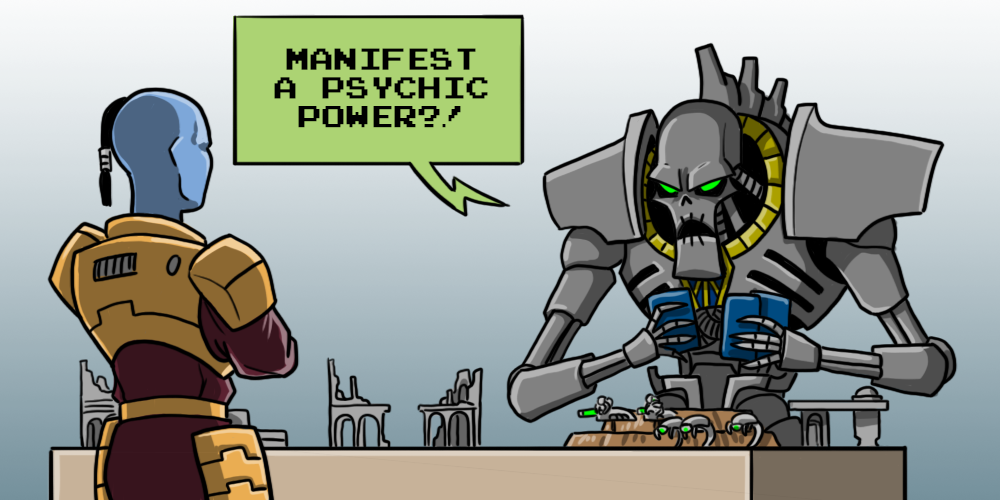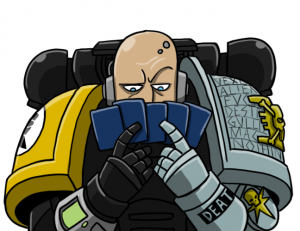This week Games Workshop dropped the largest single update we’ve ever seen to Warhammer 40,000 outside of an edition change. Through a number of FAQs and Errata, points changes, a new Dataslate, and a massive update to the Core Rules, they’ve overhauled the entire game, bringing us to what we at Goonhammer are calling “10.5 Edition.” There is a ton here to talk about and even more to take in, and we’ve split the content across a number of articles to make it easier to find what you’re looking for.
In this article we’re going to talk about the Pariah Nexus Tournament Companion, which lays out the groundwork for competitive play with the new missions pack. We’ll talk about the rules changes made by the pack, the terrain layouts, and the mission presets recommended in the pack, and how these are likely to affect your games.
If you’re looking for details of the rest of today’s massive updates, you can find them below:
Finally, before we dive in, we’d like to thank Games Workshop for providing us with a preview copy of this packet for review purposes.
What Is the Pariah Nexus Tournament Companion?
Simply put, the Tournament Companion is a set of additional rules and guidelines for playing Warhammer 40,000 at events and tournaments. This includes some additional balance changes as well as recommended terrain layouts and mission/rule combinations. This packet is designed to create the most level playing field for players meeting up to play a game using the Pariah Nexus missions.
Aren’t These Rules Just for Matched Play?
Sure they are – you don’t have to use the Tournament Companion in your casual games, or in Crusade. That said, we’d strongly recommend you use at least some of these rules when playing in casual games, as the changes in the Tournament Companion are designed to make the game more fun and feel more balanced for players of any skill level, not just tournament grinders.
While you may not be playing competitive missions in your Crusade campaign, the terrain layouts offer some really great guidance on what makes a good terrain layout in tenth edition – they include limited lines of sight, lots of usable cover, and healthy spacing of ruins around the battlefield with large footprints which can block line of sight. Even if you don’t want to build purely symmetrical battlefields, there’s a lot of great lessons to learn from how these are laid out, and for which deployment zones.

Changes to the Mission Sequence
The Tournament Companion makes three small changes to the mission sequence. First, you don’t draw cards for Primary Mission and the Mission rule – those are instead determined ahead of time, and will be in the Mission Pool. Second, as with Leviathan, the Pariah Nexus Tournament Companion makes it clear that units can walk over and end their move on top of objective markers. Finally, the Tournament Companion has players use one of its layouts for the terrain placement, rather than using any other placement method when creating the battlefield. These three points will all be familiar to Leviathan veterans.
Changes to Missions and Mission Rules
Similar to Leviathan, Pariah Nexus makes some changes to the Secondary Missions in its deck, as well as the Mission Rules. There are five key changes here:
Recover Assets cannot be selected as a Fixed Mission.
This was clearly intended as a way to prevent some pretty boring play patterns, in which one player could easily score 15 VP doing the action in their deployment zone and no man’s land in protected spots (especially with Lone Operatives), potentially doing one action in the opponent’s deployment zone at game’s end to make that 18 instead. We were worried about Recover Assets in our original Pariah Nexus review so it’s good to see they’ve addressed that.
That said, there’s now little reason to take Fixed Missions over Tactical unless your opponent easily gives up a kill secondary like Bring it Down or Cull the Horde. The ability to just discard dead secondary missions makes taking Tactical Secondaries much easier to live with.
Assassination now requires CHARACTER models to be destroyed instead of CHARACTER units when drawn as Tactical.
Nice change; helps to avoid confusion with the same card working differently for Fixed and Tactical (aside from the point discrepancy).
Cull the Horde checks the points value of the unit at the start of the battle.
I personally love this change, mostly because it was maddening looking at everyone demonstrating how clever they were being saying they’d take an understrength unit, dropping the 20th model to avoid giving up Cull the Horde VP. Well, GW thought of that very obvious solution and now dropping a model won’t help you.
Hidden Supplies adds a rider to let you choose which corners to move toward.
Now if you’re playing a mission where No Man’s Land doesn’t touch the corner of a battlefield, players roll off, and the winner selects which corner the objective marker is moved towards. This is a solid change which helps clear things up in missions using deployments where the corners are fully in a Deployment Zone, which is particularly important for the new “stepped” ones.
Scorched Earth now works properly for burning objectives.
In the Pariah Nexus missions, Scorched Earth originally only scored a player 5 points if an objective marker burned on their turn. That was a bit of a problem given the Burn Objective action finished in your opponent’s turn, meaning it would only ever actually score you points if you were going second and burning objectives in your final turn. That’s been fixed, and now any time a player burns an objective, they score 5 VP, or 10 if the objective was in their opponent’s deployment zone.

The Pariah Nexus Rules Update and FAQ
There are a few FAQ items in the Pariah Nexus Tournament Companion to clear things up (in particular around Actions), and one important rules change.
Core Rules Change: Pivots
Models that are not on a round base (Excluding AIRCRAFT models) have a pivot value of 2” unless otherwise stated.
This is a huge change, and an important one. Something we noticed immediately when reviewing the pivot rules added in the Core Rules was that MOUNTED units often had longer bases than wide – in particular units like Chaos Space Marine bikers, Logan Grimnar, Lord Invocatus, Seekers of Slaanesh, and Squighog Boyz could all gain more than 1” of movement by pivoting 90 degrees, making it possible for these units to deploy via Deep strike or Strategic Reserves just outside of 9” from an enemy unit with the long side of their base facing the enemy, then roll an 8 to charge, move forward 8”, and pivot again to gain an additional inch of movement, allowing them to make 8” charges out of Deep Strike, or possibly 6” or 7” with bonuses to charge from things like Detachment Rules or Stratagems.
This change removes that option, and while there are still several other issues with the rules and how they affect big vehicles on round bases and flying stands – we’re primarily concerned about the Monolith and Drukhari Raider – this was a good change that needed to happen to preserve some sanity. The pivot rules are interesting and they do help solve a key issue but they leave us wondering whether they create larger issues than the problems they solve.
Notable FAQ Items
- Measurement from objective markers in The Ritual is done from the center of the objective marker. This seems bonkers and counterintuitive to me. The impact here is that objectives will be about 1” closer to each other on this mission than they previously were, and putting an objective marker more than 6” away from another now means their control areas can overlap in a way that wasn’t possible before.
- Having some OC 0 models in a unit doesn’t prevent them from doing actions. Adding a character to an OC 0 unit basically means the unit can perform actions, or if your unit’s OC is reduced to 0 but you still have an OC 1 model in the mix you aren’t totally boned.
- GW codified using ruin walls and unit spacing to block charges. Well, kind of. It’s clearly more an example of “just swallowing a difficult pill rather than trying to make an insane rules adjustment work” here but GW notes that the rules for Ruins allow models to be positioned to make it difficult (or impossible) for units to charge directly through terrain features into combat. On the whole, while we don’t love the shenanigans this creates, we also think it’s better than any of the clunky alternatives tournament organizers (including Games Workshop, for a two week period in Ninth Edition) have attempted to put in place to address this.
The Tournament Mission Pool
This time around Games Workshop have released a list of twenty missions for Pariah Nexus games, and while they’ve incorporated every deployment zone and rule, it’s clear that they like some a lot more than others. There isn’t a ton to talk about here, but we’ve assembled a list of notes for things that we thought were interesting or worth talking about:
- There are only two missions each with the Sweeping Engagement and Dawn of War Deployments, and those are also the only missions which use Layout 5 – this layout appears to be designed specifically for those deployment maps, in fact.
- Unexploded Ordnance only shows up once.
- Other primary mission counts:
- Linchpin – 3
- Take and Hold – 3
- Scorched Earth – 3
- The Ritual – 2
- Burden of Trust – 2
- Purge the Foe – 2
- Terraform – 2
- Supply Drop – 2
- Each of the other Deployment Maps shows up four times.
- For Mission Rules, there’s a clear preference for the Battleline rules over mission rules that don’t give preference to Battleline Units. 13/20 of these missions use Battleline mission rules.
- Raise Banners – 3
- Stalwarts – 3
- Swift Action – 3
- Rapid Escalation – 2
- Prepared Positions – 2
There was some question when we were writing our initial Pariah Nexus Missions Review as to how often we’d see these Battleline rules in events, but it’s clear now that they’ll be common enough that you need to bank on them – I expect that any given RTT will use at least one mission with a Battleline bonus, and expecting to see two isn’t out of the question. That said, there is a real question about which rules you’ll be using and the Tournament Companion smartly recommends that Tournament Organizers not reveal which Mission Rules/Missions they’re using from the pool before lists are submitted, in order to prevent players from building for those specific missions.

Terrain Layouts
Instead of the four layouts we got in Leviathan, there are now eight layouts in the Pariah Nexus Tournament Companion. These now helpfully have measurements for the terrain, letting players set up terrain on their own with precision. That said, there were three errors we noticed in the terrain measurements when we were building versions of these layouts for the Tabletop Battles app:
- On Terrain Layout 1, The measurement to the center ruin is listed as 23” from the right side of the table. This should read 30”, as it clearly puts the ruin touching the center line across the table. It has been mislabeled.
- On Terrain Layout 2, The center ruin is listed as 23” from the right side of the table. That should read 22” and it’s drawn as 22” on the diagram, but mislabeled.
- On Terrain Layout 4, the Center ruin on the left side is listed as being 17” from the left side of the table. That should read 18”, and is drawn as such on the diagram, but is mislabeled.
These errors aren’t a huge deal, but trying to fit the angles for tilted terrain will be impossible if you aren’t using the corrected measurements. Note that we’ll have corrected measurements for these in the Tabletop Battles app. There are also a couple of places where the tilted layouts are approximate, and Games Workshop has chosen to not list measurement increments less than 0.5”.
Otherwise, these are all solid layouts. They create interesting play patterns, with some shooting lanes for ranked attacks but lots of ability to hide and move around ruins to the sides. The suggested gaps here are important as well with the new rules – in Layout 1 for example, the ruin walls as drawn suggest a gap in the corner of the ruin that is 2.8” wide – not wide enough for Magnus or a Rhino to easily push through, but wide enough for a Dreadnought on a 60mm base to walk through.
Of these, layout 2 feels the strongest to me from both an “easy to set up” and “moving around terrain” standpoint – Layout 1 can create a kind of pseudo-jail for armies with vehicles that can make it difficult to deploy out of line of sight without also being in a spot that takes two turns to drive out of. Layouts 2, 3, and 4 are much more reasonable for this.
Layout 8 is pretty intriguing here, using the four small ruins to create a semi-open zone in the middle of the table that lacks some of the staging areas of the other deployment maps. It’s still possible – if difficult – to protect units in that spot, but it’s also much more accessible to vehicles than the middle of the board is on other deployment maps. Layout 8 is used for Tipping Point, Hammer and Anvil, and Crucible of Battle and of those, Crucible is the one that worries me the most since it has potential for sight lines that go across the table from the jump.
Ultimately, that’s the rub with the angled terrain – how it’s angled can make a huge difference, and that puts the pressure on players to make sure those measurements are correct so that the middle of the table is merely “difficult” to hide in and not “impossible.” The angled terrain placements offer a lot of upside making the layouts feel more varied, but precision with them is going to be key.

What It All Means
The Pariah Tournament Companion acts as the capstone on the massive set of updates we’ve received this week, completing the picture on how this all fits together. Not neatly, mind – there’s an absolute ton of new developments and understanding it all from even a detailed reading of the rules updates and FAQs is well beyond the abilities of we mortals. That said, now that we have the full picture, we can start to speculate about how things will change.
There are four really big adjustments here:
- Recover Assets not being a Fixed Objective option essentially kills Fixed as an army strategy. There’s still going to be value in going with fixed objectives against certain armies, but building your army specifically to score Fixed is just not anywhere near as feasible as it was with Recover Assets out of the mix. Yeah, Behind Enemy Lines + Establish Locus is still an option, but with only 2 VP for being in the center there you have to be able to reliably go up and down every turn to have any shot at scoring big points on it, and those actions have to be done in the enemy deployment zone. With the changes to Tactical Objectives making it easier to discard “dead” objectives, both built-in to the cards and with the ability to use the New Orders Stratagem multiple times per battle, it’s not clear that there’s a lot of incentive to take Fixed Objectives outside of matchups where the kill secondary option is too good to pass up.
- Cull the Horde can’t be dodged with under-strength units. Pour one out in particular for Derek Apsche’s Chaos Cult list, which he took to an impressive 7-1 finish at the Atlantic City Open last weekend. It’s a hell of a run, but this basically kills it dead – an army which gives up maximum points for Cull the Horde and Assassination just isn’t feasible in competitive play, especially with units as spongy as those in the Chaos Cults army. Many armies can get over giving up max points for one kill secondary objective, but I don’t think any succeed when they easily give up two. Chaos Knights still have lots of play, especially now that Bring it Down requires killing ten War Dogs, but if six of them were CHARACTERS, it’d be dead in the water.
- Pivot Changes. Look, this needed to happen. Bikes and other MOUNTED units were going to be a real problem and while there are still more than a few problem vehicles which can make those short charges, we’re fans of removing as many loopholes as possible. This is one of those things that causes us to say “yeah, everyone should use the tournament companion” – there’s just no upside to playing without this Core Rule change.
- Most missions in the pool benefit BATTLELINE units. As we mentioned, 13/20 of the missions in the Pariah Nexus Mission Pool have Mission Rules which benefit BATTLELINE units. These benefits aren’t huge – Stalwarts is among the strongest of them – but they do create enough benefit that armies with good BATTLELINE units will want to bring them.
Have any questions or feedback? Drop us a note in the comments below or email us at contact@goonhammer.com. Want articles like this linked in your inbox every Monday morning? Sign up for our newsletter. And don’t forget that you can support us on Patreon for backer rewards like early video content, Administratum access, an ad-free experience on our website and more.


